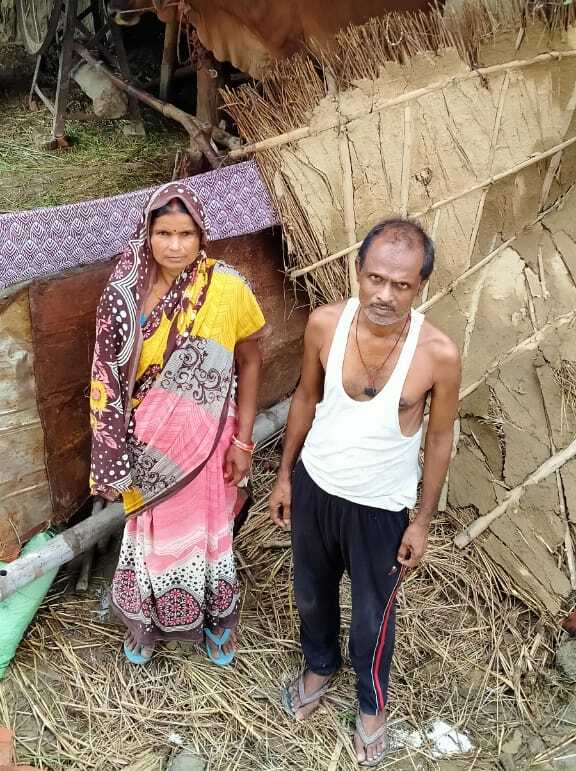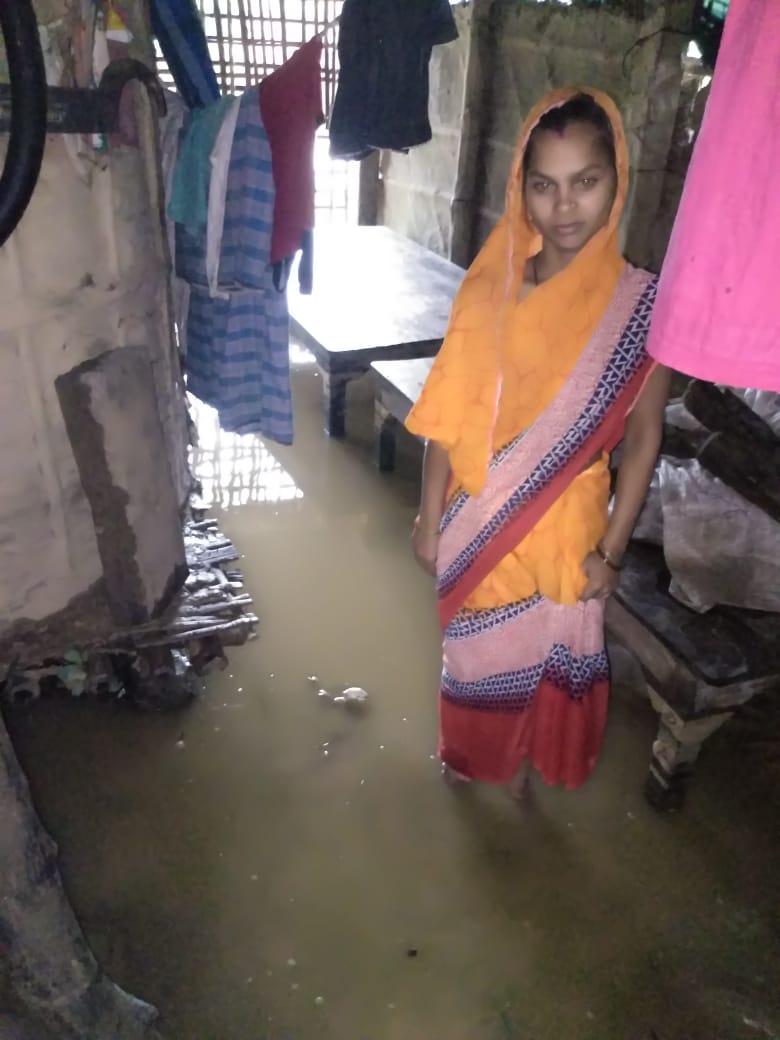Monsoon in Bihar is synonymous with floods. But, villages along the India-Nepal border in north Bihar face up to 66 flash floods a year
There are at least 72 known transboundary rivers that flow into north Bihar from Nepal. These rivers, many of them seasonal, cause flash floods throughout the year causing recurring damages to the local people. These losses are neither recorded nor compensated.


Floods in Bihar are not caused due to heavy rainfall in the state alone. Photo: WaterVagabond
In the midnight of July 11-12, Amish Chand Singh jumped out of his bed and rushed to save his wife and three children sleeping in their mud house in Rupaliya village of Gaunaha block in Paschim (West) Champaran, Bihar. Without losing any further time, the family members collected as many belongings as possible and rushed out to find a slightly higher location in the village.
Another flash flood was upon them.
All they could do was to stand at a higher elevation and wait. Wait for the water level to drop, which could take two to three hours or the entire night.
It had rained heavily on July 11 and both the Chhegraha and Amawa rivers (small tributaries of Burhi Gandak river), known to cause flash floods, were in full spate. That night, as the family waited, Chand Singh’s mud house was washed away in the swift currents of the flash flood. And, he was not the only one whose house was damaged. A number of residents of Rupaliya village lost their belongings with house damages.

“My house got washed away in front of my eyes. I could not do anything. Only debris is left there,” Chand Singh told Gaon Connection. “Bhay bana rehta hai ki kab kya ho jaye (We remain scared wondering what would happen next),” he added.
These villagers of Gaunaha block in Paschim Champaran, near the India-Nepal border, are no strangers to flash floods. Every time it rains heavily in Nepal, a number of small rivers, including transboundary rivers, come alive and flood the border villages. And these flash floods are not limited to five-ten times a year, but their incidence is as high as 66 times in a year.
During each such flash flood, residents like Chand Singh lose their belongings, which are never accounted for, and fail to make to the official flood loss records of the state. They receive no media attention either.

“There are around 72 transboundary rivers in Paschim Champaran, Purvi Champaran, Sitamarhi, Madhubani, Araria, and Kishanganj districts of north Bihar along the India-Nepal Border. Most of these are seasonal rivers, but they wreak havoc in nearby villages whenever it rains in Nepal,” Eklavya Prasad, managing trustee of Megh Pyne Abhiyan told Gaon Connection. For the last 15 years, Prasad is working on floods, water and sanitation issues in north Bihar.
Bihar, whose 73 per cent geographical area is prone to floods, is once again in the news. At least 12 people have died due to floods in various districts of north Bihar. On July 13, an elderly in Madhubani was washed away due to floods caused by heavy rains. Another one died in Samastipur district and two in Sitamarhi due to flash floods.
Floods in Bihar are not caused due to heavy rainfall in the state alone. A number of Himalayan rivers from Nepal flow down into the flood-plains of Bihar, making it India’s most flood-prone state. While the riverine floods are limited to the monsoon season, flash floods that affect the villages along the India-Nepal border occur throughout the year.
Take the case of Chand Singh, a tailor by profession, who earns Rs 10,000 a month. This is not the first time he lost his house. During the flash floods of 2017, his mud house was washed away.
“I worked hard and saved some money. It cost me around Rs 4,000 to repair my mud-house post 2017 floods. But, my house has again swept away. I will have to rebuild it,” he said in a fatalistic tone.
“Due to the flash floods on July 11-12 night, about four-five villagers lost their houses. Roads have been damaged, too. The debris has clogged our homes,” Binita Kumari, a resident of Rupaliya village told Gaon Connection .
“Just two kilometres away from our village is thick forest and hills of Nepal. Every time it rains, flash floods come from the north and gush toward the south, destroying the villages, such as ours, on their way. It happens multiple times in a year,” she added.

Bihar floods this year, so far
A number of villages in Paschim Champaran district of Bihar are water-logged due to the recent heavy rains and floods. Farmers have lost their crops, as several rivers in north Bihar are flowing above the danger mark.
Chanpatia town and areas near Gopalganj are inundated at present. “As of now, embankments have not breached, but we are not sure how long they can withhold the pressure of rising waters,” Vinay Kumar, a resident of Jagdishpur in Pashchim Champaran told Gaon Connection. He is the secretary of a local non-profit, Water Action. “River Gandak is in full spate. Meanwhile, we fear the embankments of Burhi Gandak river may break soon,” he added.
“In the name of maintenance, the authorities just dropped some boulders and sand on the embankments. The government is not bothered. It has no interest in our plight. When we see dark clouds, we fear flash flood,” he lamented.
According to him, people in the area were already living on platforms raised by three to four feet. “If water levels rise any further, people would run towards the embankments and roads, and live there,” he said.
While villages in Pashchim Champaran are still under flood threat, rivers in some other districts of north Bihar have started to calm down.
“As of now, water level in the Bagmati river is decreasing. It rained heavily last night, but there’s no risk here as of now,” Suman Kumar, who lives around 20-25 kilometres from the embankment of Bagmati river in Sitamarhi, told Gaon Connection .

Similarly, Ankur Mandal, who lives in Naruar village of Madhubani district told Gaon Connection that water level in Kamla Balan river had started to fall.
But, there’s no respite for the villages along the India-Nepal border who regularly face flash floods. “Flash floods are more dangerous than riverine floods in big rivers, as former have very high currents that washes away everything coming their way including people and cattle,” said Vinay Kumar. “These flash floods are not limited to the monsoon season alone. This year, we had flash floods in February and April months,” he added.
Small rivers, big role
Explaining the context of flash floods along the India-Nepal border, Prasad said: “There are two types of rivers that flow from Nepal. The big ones like Kamla, Kosi and Gandak; and a large number of small rivers, many of whom are seasonal. We often neglect these small, yet important, rivers and notice them only during the monsoon.”
According to him, there are around 72 transboundary rivers in Paschim Champaran, Purvi Champaran, Sitamarhi, Madhubani, Araria, and Kishanganj districts of north Bihar along the India-Nepal Border.
Megh Pyne Abhiyan has done comprehensive studies on flash floods in the region. Its field-based research shows the frequency of floods in Harkatwa village in Gaunaha block of Pashchim Champaran is very high. “In 2016, the village had 60 flash floods, that is, at least once every week. Similarly, in 2007, Rupaliya village faced at least 40 flash floods. But in 2013, flash flood incidence had increased to 66,” informed Prasad.
It is time to give these small rivers more attention, if flash floods along the India-Nepal border are to be addressed. Measures to control riverine floods are different from ways to manage the flash floods. The entire state machinery’s focus is on riverine floods, with no care towards the sufferings of people like Chand Singh who lose their belongings several times in a year to these recurring flash floods.
“First and foremost, we need to have complete knowledge about all these transboundary rivers and map them. For now, we know about 72 such rivers, but there maybe be many more. We need to understand the behaviour of these small rivers that cause big damages,” said Prasad.
In riverine areas, there is displacement for three to four months during the monsoon season. But, in villages like Harkatwa and Rupaliya, local villagers are vulnerable throughout the year. Both their sufferings and losses don’t count. And this must change.

